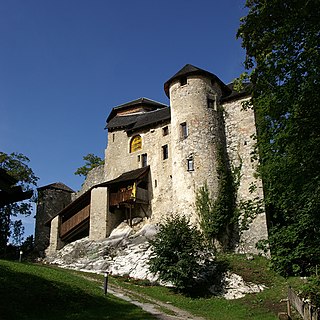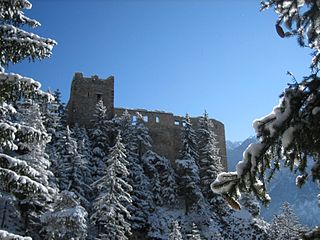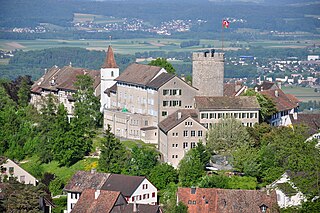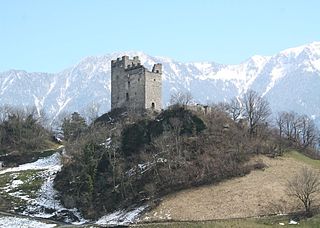
The Abbey of Saint Gall is a dissolved abbey (747–1805) in a Catholic religious complex in the city of St. Gallen in Switzerland. The Carolingian-era monastery existed from 719, founded by Saint Othmar on the spot where Saint Gall had erected his hermitage. It became an independent principality between 9th and 13th centuries, and was for many centuries one of the chief Benedictine abbeys in Europe. The library of the Abbey is one of the oldest monastic libraries in the world.

The canton of St. Gallen or St Gall is a canton of Switzerland. Its capital is St. Gallen.

Neu-Ems Castle is a medieval castle in Hohenems in the province of Vorarlberg, Austria. It was the fortification of the nobility Herren von Ems. Neu-Ems Castle is 666 metres (2,185 ft) above sea level.

Clanx Castle is a ruined castle in the Appenzell District of the canton of Appenzell Innerrhoden in Switzerland.

Hohensax is a ruined castle in the Sennwald municipality in the Swiss canton St. Gallen. The castle was built around 1200 by the barons of Sax, and was destroyed in 1446. In 1248, the castle passed to Ulrich von Sax, founder of the Sax-Hohensax line of the noble family. The castle was plundered in a feud of 1393, and sold together with the villages of Sax and Gams to the dukes of Austria. In the Old Zürich War, the people of Appenzell captured and slighted the castle in 1446. After this, the barons of Hohensax resided in the nearby Forstegg castle at Salez. In 1640, the ruin passed to the barony of Sax-Forstegg, one of the constituent parts of the canton of Linth of the Helvetic Republic in 1798, and later the canton of St. Gallen. It included the villages of Sax, Salez and Gams.

Hagenwil Castle is a castle in the municipality of Amriswil of the Canton of Thurgau in Switzerland. It is a Swiss heritage site of national significance. It is the only remaining intact water castle in eastern Switzerland.

Belfort Castle is a ruined castle in the municipality of Brienz/Brinzauls of the Canton of Graubünden in Switzerland. It is a Swiss heritage site of national significance.

Marschlins Castle is a castle in the village of Igis of the municipality of Landquart of the Canton of Graubünden in Switzerland. It is a Swiss heritage site of national significance.

Fracstein Castle is a castle in the municipality of Seewis im Prättigau of the Canton of Graubünden in Switzerland. It is a Swiss heritage site of national significance.

Sogn Parcazi Castle and Church is a ruined castle and fortified church in the municipality of Trin of the Canton of Graubünden in Switzerland. It is a Swiss heritage site of national significance.

Belmont Castle is a ruined castle near Flims, Graubünden, Switzerland. It was the home of the Barons of Belmont.

Regensberg Castle is a hill castle which was built about the mid-13th century AD by the House of Regensberg in the Swiss municipality of Regensberg in the Canton of Zürich.

Alt-Regensberg Castle is a hill castle which was built about the mid-11th century AD by the House of Regensberg in the Swiss municipality of Regensdorf in the Canton of Zürich.

Uster Castle is a hill castle which was built probably around 1200 AD by the House of Rapperswil in the Swiss municipality of Uster in the Canton of Zürich. Since 1995 it houses a boarding school.

The noble family von Sax or Saxe was a medieval noble family in eastern Switzerland. They owned estates and castles on both sides of the Alps in the modern cantons of St. Gallen, Graubünden and Ticino. The origin of the family is unknown, but they probably stem from Churrätien nobility and were related to the da Torre family. The family divided into two main lines; the Grafen (counts) von Sax-Misox and the Freiherren (barons) von Hohensax.

Solavers Castle is a castle in the municipality of Seewis im Prättigau of the Canton of Graubünden in Switzerland.

The Lordship of Sax-Forstegg was a territory in the Alpine Rhine Valley, including the settlements of Sennwald and Altstätten, now part of the canton of St. Gallen, Switzerland. It was named for the baronial family of Sax and their castle Forstegg. It was created with the division of the old Lordship of Sax into Hohensax and Frischenberg in the late 14th century. In 1458, the lords of Sax-Forstegg entered a pact with the Swiss Confederacy. In addition, they were also citizens of St. Gallen from 1463, and citizens of Zürich from 1486.

Wartau Castle is a ruined castle in the municipality of Wartau of the Canton of St. Gallen in Switzerland. It is a Swiss heritage site of national significance.
Ulrich von Sax was Abbot of Saint Gall from 1204 until his death.

The Ramschwag Ruins are the ruins of a castle in the east of the municipality of Häggenschwil, in the Swiss canton of St. Gallen.




















